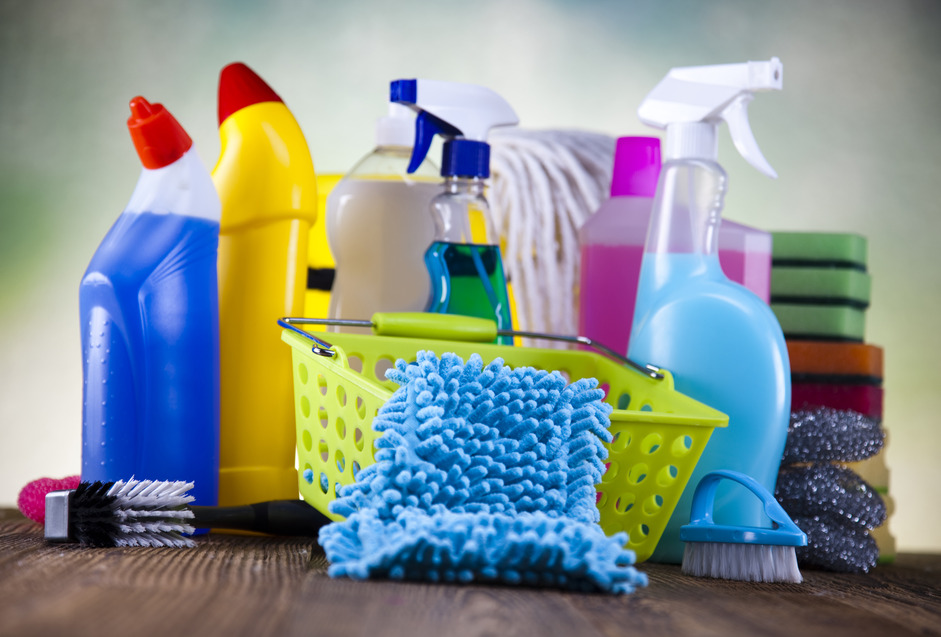These tricks and tips will help you outsmart dirt while cutting back on housework.
Giving your home that spring-clean feeling takes some elbow grease, but these ideas make it easier to fight those dirty jobs faster and less often.
1. Defy Dust
Trick: You can combat dust by adjusting your home’s humidity level.
The facts: Low humidity levels cause static electricity. Not only does static attract dust, it makes it stick, so it’s difficult to remove. High humidity causes problems, too — it’s an ideal environment for dust mites. These microscopic critters are a double threat: They’re a common allergen, and they contribute to dust production. There are as many as 19,000 dust mites in half a teaspoon of house dust, according to the American College of Allergy, Asthma, and Immunology. Yuck!
Next steps: Keep your home’s humidity level between 40% to 50%. That’ll eliminate static while decreasing dust mite growth.
Tip: Make it easy to keep your household vents dust free. Remove and wash them once a year with mild soap and water. After they’re clean and completely dry, apply a liberal coat of car wax; then buff.
2. Keep Glass Shower Doors Crystal Clear
Trick: You can eliminate soap scum build-up by coating your glass shower doors with a rain-repellant product made for car windshields.
The facts: When applied to glass, products like these create an invisible barrier that causes water, oils, and debris (like soap suds) to bead and roll off.
Next steps: Find this product anywhere that sells basic auto supplies. You’ll know it’s time to reapply when water stops beading on shower doors. Keep in mind, windshield rain repellants were made to treat glass, not plastic.
Tip: Automatic shower cleaners claim to let you clean your shower and tub less frequently — like every 30 days. After you finish bathing, the gadget will douse your shower and tub with a cleanser that prevents soap scum build-up while combating mold and mildew. You can buy automatic shower cleaners at most big-brand retailers, like Target and Walmart.
Related:
- Green Clean Your Bathroom for Pennies
- 5 Things You Forgot to Clean in Your Bathroom
3. Seal Your Stone Countertops
Why: Natural stone countertops, including granite and marble, are porous, so if they’re not sealed, liquids like red wine, juice, or soy sauce can stain them.
The facts: A countertop sealer repels stains by causing spills to bead instead of getting absorbed. Likely, your contractor sealed your countertop when it was installed.
Next steps: To keep your countertops in tip-top shape, re-apply sealer twice a year. To see if you need a fresh coat, pour a tiny bit of water on your natural stone countertop. If the water doesn’t bead or doesn’t stay beaded for two to three minutes, it’s time to reseal.
Tip: Shopping for stone countertops? Slabs with lots of swirls or veins tend to be more porous.
4. Protect Your Furniture and Carpets
Why: Protective furniture sprays and carpet sealants guard against inevitable spills. Some of these products also protect fabrics from fading and resist mold, mildew, and bacteria.
The facts: Protective sprays and sealants, like Scotchgard and Ultra-Guard, cause liquids to bead on the surface instead of being absorbed.
Next steps: Apply the appropriate sealer once a year after a deep upholstery and carpet cleaning.
Tip: In the future, you may not need to buy a protective furniture spray or carpet sealer thanks to a new fabric coating that repels dirt and water. It’s made by Liquipel, the company that created a water-shield substance to protect cell phones, MP3 players, and other electronic devices. The company plans to release a water-repellent clothing line next year. We bet household fabrics and materials will be next.
Rust-Oleum introduced a similar product, NeverWet, last year. But the company doesn’t recommend it for furniture, because the product “will repel liquids when applied to fabric, but will change the appearance.“
5. Give Oven-Cleaning Products the Boot
Why: Most cleaners give off noxious fumes and make a horrible mess.
The facts: The basic ingredient in many oven cleaners is lye, which can burn your eyes and your skin; it’s usually fatal if swallowed.
Next steps: Use a wet pumice stone to scrape off dirt and grease. It’s faster than oven cleaner and toxin-free.
Tip: Need to wipe your range or anything else down? You can bust filth faster by heating up a clean, damp sponge or cloth in a microwave for 30 seconds before wiping with or without a cleaning product. Put on rubber gloves before you pick up that hot sponge.
Related: Green Clean Your Kitchen to Avoid Chemicals
6. Keep Things Tidy with Quick Touch-Ups
Why: Small cleaning projects prevent filth from building up.
The facts: When you spot clean daily, you can prevent smudges from staining, banish dust bunnies, and even combat allergens.
Next steps: Create a spot-cleaning kit so you can address small, dirty situations in minutes.
- Cleaning pads are great for eradicating dirty fingerprints on walls and light switches.
- Damp micro-cloths can reduce airborne dander when used daily to wipe down pets.
- Dry sweeper cloths can quickly pick up dust and dry dirt off floors, shelves, and electronics.
Tip: Keep stored items cleaner longer by shutting closets, cabinets, and drawers, so circulating dust and dirt can’t get in.
7. Ditch Your Outdated Low-Wattage Bulbs
Why: Good lighting can make you and your home look and feel great.
The facts: A room lit with low-wattage incandescent bulbs and compact fluorescents can look dark and dingy. “Daylight” bulbs brighten things up. These full-spectrum light bulbs mimic natural light, so they give better visual accuracy. Bonus: Like sunlight, these bulbs can boost your mood.
Next steps: When shopping for bulbs, look for those marked “daylight” that have a range between 5,000 to 6,500 kelvins.
Tip: Don’t understand the difference between warm white bulbs and daylight bulbs? Check out the video for a side-by-side comparison:
Related:
- Save Energy and Feel Better with Daylighting
- Did You Know that Dirty Light Bulbs Waste Energy?
8. Use a Cleaner Sweeper
Why: Brooms hold on to dirt.
The facts: You don’t want to just push dirt around when you sweep. You can use spray dusters (like the ones used on computer keyboards) to blow dust bunnies off brooms, and soapy water to get rid of the grime. But how about combing dirt off broom bristles while you’re sweeping?
Next steps: Check out the Broom Groomer. It was invented by a guy who cut his hand on broken glass when it got stuck on the bristles of his broom. Watch the video to see how it works:
Tip: About 80% of dirt in homes walks in from the outside. Stop dirt with a bristly doormat before it’s tracked inside.
By: Deirdre Sullivan:© Copyright 2015 NATIONAL ASSOCIATION OF REALTORS®





